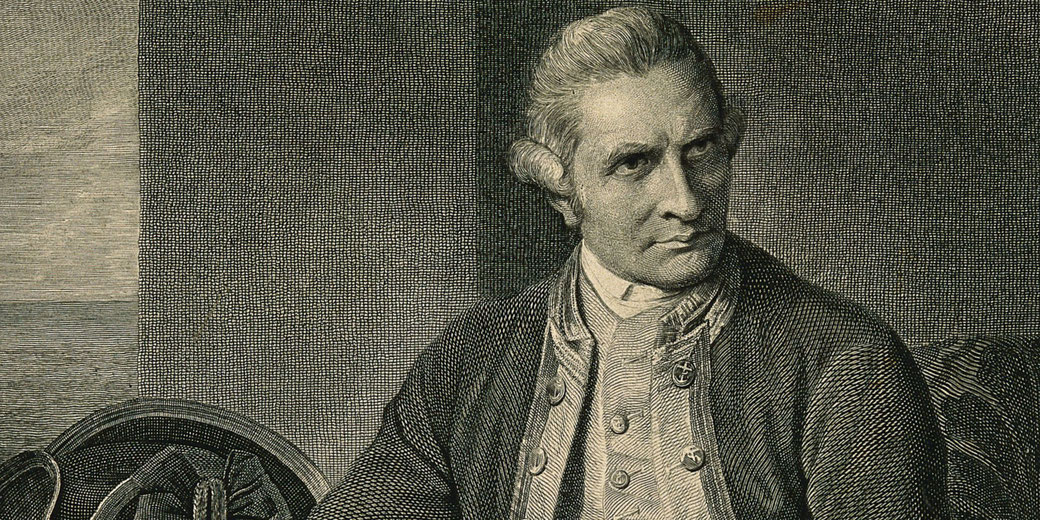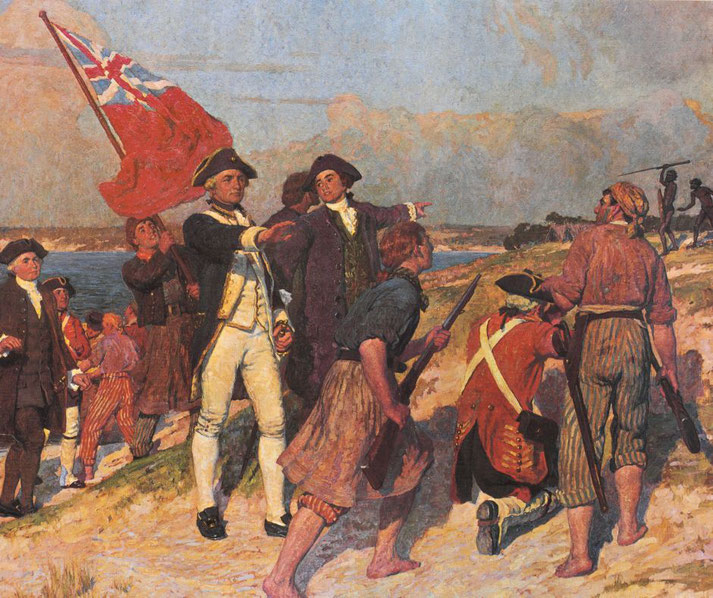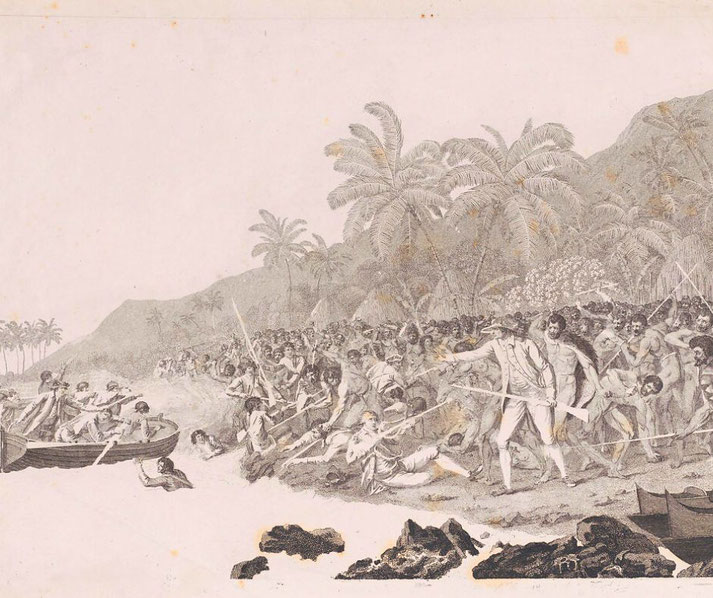The amazing life and gruesome death of Captain Cook, the explorer who 'discovered' Australia

Captain James Cook embarked on a series of voyages that would forever change the course of history. Born into humble beginnings in 18th-century England, Cook rose through the ranks of the Royal Navy to lead three groundbreaking expeditions across the uncharted waters of the Pacific Ocean.
His journeys not only expanded the boundaries of the known world but also contributed significantly to the fields of cartography and natural science.
However, his remarkable achievements are marred by cross-cultural misunderstandings.
From a laborer's son to the Royal Navy
James Cook was born on November 7, 1728, in the village of Marton, Yorkshire, England, into a humble family.
His father was a farm laborer, and Cook's early life was far from the seafaring adventures that would later define him.
At the age of 16, he moved to the coastal town of Whitby, where he was apprenticed to a shipowner and coal merchant.
This experience provided Cook with his first taste of life at sea, as he learned the trade aboard collier ships transporting coal along the English coast.
Cook's skills and ambition quickly set him apart. In 1755, he made a significant decision to enlist in the Royal Navy, a move that would propel him into the heart of maritime exploration.
His early naval career saw rapid advancement, thanks in part to his proficiency in mathematics and cartography.
Cook's talents were recognized during the Seven Years' War (1756-1763), where he served in North America and demonstrated his exceptional mapping abilities by charting the treacherous waters of the Saint Lawrence River, aiding the British capture of Quebec City in 1759.
Following the war, Cook's expertise in navigation and surveying continued to earn him important assignments.
He was tasked with mapping the coast of Newfoundland, a project that further honed his skills.
Cook's meticulous charts and attention to detail caught the attention of the Royal Society, the oldest national scientific society in the world.
The first voyage and encountering Australia
Cook embarked on his first voyage of discovery aboard HMS Endeavour in 1768, a mission that would last until 1771.
The expedition was initially prompted by the Royal Society's desire to observe the transit of Venus across the sun, an event that would occur in June 1769.
This phenomenon was crucial for improving the accuracy of astronomical measurements, particularly for determining the Earth's distance from the sun.
Cook's secret orders, however, also included the search for the elusive southern continent, Terra Australis, believed to exist in the uncharted waters of the South Pacific.
The Endeavour set sail from Plymouth, England, on August 26, 1768, with a diverse crew that included astronomers, naturalists, and artists.
After rounding the tip of South America, Cook navigated to Tahiti, where the transit of Venus was successfully observed on June 3, 1769.
The expedition then continued to explore the Society Islands, establishing friendly relations with the Polynesian inhabitants and recording detailed ethnographic and botanical observations.
Cook's journey took a significant turn when he sailed southwest, reaching the coast of New Zealand in October 1769.
Over the next six months, he meticulously charted the two main islands, disproving the theory that they were part of a larger southern continent.
In April 1770, Cook made his first landing on the east coast of Australia at a place he named Botany Bay, due to the abundance of unique plant species collected by the ship's naturalists.
This is where the first encounter between Europeans and the Indigenous peoples of Australia occurred.
While initial interactions were cautious, they were generally peaceful. Cook's crew observed and recorded aspects of the First Nations' way of life, although these observations were limited and sometimes misinterpreted.
Cook then continued northward, charting the coastline and navigating through the Great Barrier Reef, a treacherous passage that tested his seamanship.

The voyage concluded with a return journey via the Dutch East Indies (modern-day Indonesia) and the Cape of Good Hope, arriving back in England on July 13, 1771.
The expedition was hailed as a triumph, significantly expanding European knowledge of the Pacific region and laying the groundwork for further exploration and colonization.
Cook's detailed maps and observations provided valuable insights into the geography, flora, fauna, and cultures of the areas he explored, earning him a reputation as one of the greatest explorers of his era.
The second voyage and testing Cook's endurance
Cook's second voyage of exploration, which took place from 1772 to 1775, aimed to further explore the South Pacific.
This time, Cook commanded the HMS Resolution, accompanied by the HMS Adventure, captained by Tobias Furneaux.
The expedition was notable for its extensive use of chronometers, a new technology that significantly improved navigation by allowing accurate measurements of longitude.
The expedition departed from England on July 13, 1772, and headed south, crossing the Antarctic Circle for the first time in January 1773.
Cook and his crew braved extreme cold and treacherous ice conditions, pushing further south than any previous explorer.
Throughout the voyage, Cook's ships visited numerous Pacific islands, including Easter Island, the Marquesas Islands, Tonga, and New Caledonia.
In these places, Cook continued his practice of making detailed maps and collecting scientific and ethnographic information.
The expedition also witnessed the separation and reunion of the Resolution and Adventure, with Furneaux's crew returning to England separately after exploring parts of Tasmania and New Zealand.
In addition to its geographic discoveries, the second voyage was remarkable for its achievements in the field of health and nutrition.
Cook implemented strict hygiene and dietary measures, including the consumption of sauerkraut and malt wort, which prevented scurvy, a common and deadly disease on long sea voyages.
This focus on crew well-being resulted in an unprecedented low mortality rate for the time.
The expedition returned to England on July 30, 1775, after an absence of three years.
The third voyage and rising tensions
Cook's third and final voyage, undertaken from 1776 to 1779, was driven by the quest to locate the Northwest Passage, a hypothetical sea route connecting the Atlantic and Pacific Oceans through the Arctic.
Cook commanded the HMS Resolution once again, with the HMS Discovery, captained by Charles Clerke, accompanying him.
The expedition set sail from England on July 12, 1776, with a crew that included notable figures such as William Bligh, who would later gain fame from the mutiny on the HMS Bounty.
The search for the Northwest Passage led Cook into the icy waters of the Arctic. Although he sailed through the Bering Strait, ice blocked his progress, and he was forced to turn back without finding the sought-after passage.
Disappointed, Cook decided to return to the Hawaiian Islands, which he had visited earlier in the voyage and named the Sandwich Islands.
Cook's time in Hawaii would mark the tragic end of his illustrious career. Initially welcomed by the Hawaiians, tensions arose during his second visit in 1779.
A brutal end to an incredible life
James Cook met a tragic end in a confrontation with Hawaiian Islanders at Kealakekua Bay on February 14, 1779.
Cook's interactions with the Indigenous peoples of Hawaii were initially cordial, with exchanges of goods and information.
However, the prolonged presence of his crew led to tensions and conflicts with the local population.
Cook's attempt to take a Hawaiian chief hostage as leverage to recover a stolen boat led to a violent clash, resulting in his death at the hands of the islanders.
Cook's body was subjected to traditional Hawaiian funerary practices, which included the removal of flesh from the bones.
This process was actually a sign of respect in Hawaiian culture, as they believed it freed the mana (spiritual power) of the deceased.
Some of Cook's remains were eventually returned to his crew, who conducted a formal burial at sea on February 21, 1779.
The exact location of his remains is unknown, as only a portion was recovered and given a maritime burial.

The ongoing tensions around Cook's legacy
While Cook is celebrated for his navigational and scientific achievements, his voyages also played a role in the expansion of European colonial empires, with profound consequences for Indigenous peoples.
In recent years, there has been growing recognition of the negative aspects of Cook's expeditions, including their role in the dispossession and suffering of Indigenous communities.
The arrival of Europeans marked the beginning of significant changes to traditional ways of life, land ownership, and cultural practices.
In some cases, Cook's encounters with Indigenous peoples led to violence and conflict, and his maps and discoveries paved the way for further colonization and exploitation.
The commemoration of Cook has become a contentious issue, particularly in countries such as Australia and New Zealand.
While some view him as a hero and a symbol of exploration and discovery, others see him as a representative of imperial conquest.
This has led to debates over the appropriateness of statues, place names, and celebrations associated with Cook.
Efforts to reevaluate Cook's legacy have included a greater emphasis on understanding the perspectives of the Indigenous peoples he encountered.
There is a growing movement to acknowledge the resilience and resistance of these communities and to incorporate their narratives into the historical record.
Further reading
What do you need help with?
Download ready-to-use digital learning resources
Copyright © History Skills 2014-2025.
Contact via email
With the exception of links to external sites, some historical sources and extracts from specific publications, all content on this website is copyrighted by History Skills. This content may not be copied, republished or redistributed without written permission from the website creator. Please use the Contact page to obtain relevant permission.





